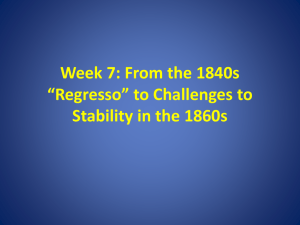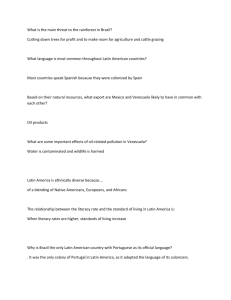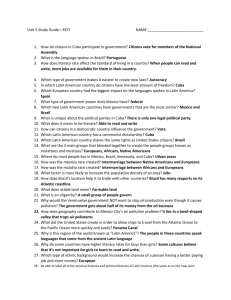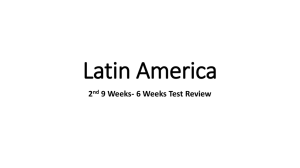Bellringer
advertisement
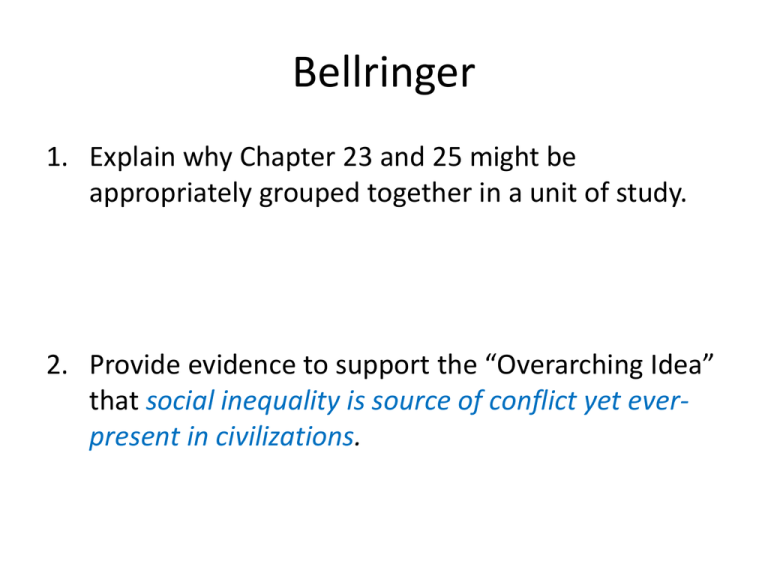
Bellringer 1. Explain why Chapter 23 and 25 might be appropriately grouped together in a unit of study. 2. Provide evidence to support the “Overarching Idea” that social inequality is source of conflict yet everpresent in civilizations. Neo-Colonialism • Neo-colonialism- politically independent but developing nations are controlled through trade and economics rather than governmentally • Where? • When? • Why? Case Studies Mexico 1. - Brazil • - 2. 3. - • - 4. - 5. 6. 7. - • - Migration ~a window on 19th century life~ -consider the timing, origins, destinations Push Factors • Problems – Famine – Weak economy – Unstable gov’t Pull Factors • Promise of a “better life” – Job opportunities – Gov’t stability, choice – Education Year 1820 1825 1830 1835 1840 8,385 10,199 23,322 45,374 84,066 1845 114,371 Year 1850 1855 1860 1865 1870 369,980 200,877 153,640 248,120 387,203 1875 1880 1885 1890 1895 1900 1905 227,498 457,257 395,346 455,302 258,536 448,572 1,026,499 1910 1,041,570 Persons Obtaining Legal Permanent Resident Status Fiscal Years 1820 to 2010 Country/Year China France Germany Ireland Italy Russia United Kingdom Total Foreign Born % Foreign Born Total Population 1830* 1850 9 8 54 54 584 962 1880 104 107 1,967 1,855 27 108* 0.8%* 12,785 1830 379 2,244 9.7% 23,191 1850 918 6,679 13.3% 50,155 1880 1900 2,663 1,615 484 424 1,168 10,341 13.6% 75,994 1900 Global Migrations of the 1800s Industrialization The Great Migration • Rural to urban migration as nations industrialized • Long distance migration from urban to urban migrations – lower class Europeans fled to U.S., Latin America, Australia • Chinese migrants fled famine & revolts to move to U.S., Peru, Mexico, filling labor needs after slavery abolished W. Europe 1750-1850 1850-1914 Latin America • Which of the following ran counter to the democratic impulses associated with the American Revolution? a) Rejection of aristocratic notions of hierarchy in the thirteen colonies b) Continued centrality of slavery to the colonial socioeconomic order c) New England's tradition of town meetings d) Virginia's practice of election of a House of Burgesses e) Demands for representation in British Parliament • Which traditions of the French Revolution did not survive long beyond the initial and radical phases? a) b) c) d) Universal male suffrage Attack on feudal privilege and institutions Popular nationalism The metric system • What was the main commonality Liberal and Conservative politicians shared in nineteenthcentury Latin America? a) They agreed that the Catholic Church had too much power. b) Both were led by wealthy landowners and the urban middle to upper classes. c) They agreed on the immediate abolition of slavery and repatriation to Africa. d) Both looked with admiration on the example of independent Haiti. e) Both were influenced by the ideas of Karl Marx. • What impact did the instability of the wars for independence have on subsequent developments in Latin America? a) Agricultural regions devastated by modern warfare were slow to recover, leading to widespread famine. b) Female veterans of military service refused subordinate roles in the home. c) Military leaders remained influential and intervened frequently in political affairs. d) Mestizo, slave, and indigenous populations formed guerrilla units and launched armed struggle for communism. e) The grip of the Catholic Church was weakened and various strains of Protestantism became the dominant form of Christianity. • Which area of the 19th century Latin American economy was most damaged by free-trade relations with the British? a) b) c) d) e) Rail Port city Manufacturing Ranching Agricultural • Why was the struggle for Brazilian independence distinctive in Latin American history? a) Brazil was the only colony whose economy was dependent on cash crops. b) Brazil remained a monarchy after independence. c) Brazil abolished slavery before independence was achieved. d) Brazil was the first colony to achieve independence. e) Brazil was the only ethnically diverse colony where racial hierarchy did not exist before or after independence. • Which best characterizes the rule and impact of Porfirio Diaz in Mexico? a) Sacrifice of liberal political principles in pursuit of industrial and infrastructural modernization b) Peasant-based populist mandate achieving comprehensive land reform c) Puppet ruler manipulated by German imperialism bringing little to no economic development d) Conservative ruler who returned large landowners and Catholic elites to power e) Communist revolutionary implementing a series of Five-Year Plans for agriculture and industry


